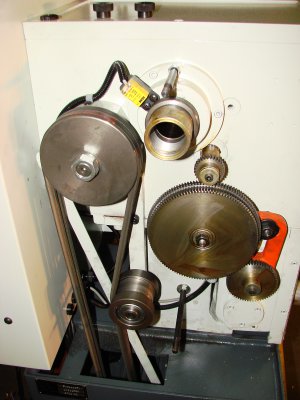I second Davids suggestion. Also, post a video without the chuck on. Or with it just in between gears so the chuck is not turning.
I am betting that it is either the top/larger pulley, as it is is cast iron, or settings with the VFD, or a combination. Just had a conversation with someone at the factory, and they say to replace that top cast pulley with a fully machined pulley since you put the VFD on. They also said be sure not to go above 60HZ on the motor settings, because the stock setup and motor only go that fast.
I don't have a problem with a little faster than that, but that is up to you guys. Just don't run it at 400HZ and tell me the headstock is getting hot and the 4 jaw chuck flew apart.
And good point Rich, but Rio that drawing you made about the fulcrum is outside of where the lathe bolts down though. Maybe get someone to push on it and look at the machine. See where its moving.
If there is a problem with the machine, it WILL be taken care of. But just remember, I don't build them, I am not a magician or a mind reader that can tell you in an email what it is.
But whatever the problem is, I am here to help figure it out and get it taken care of. The hardest part is that these both have VFD's on them, so that part of it changed from the factory, so there are just a few extra variables in it. But if it ends up being a VFD related issue, I am billing everyone for the time I am spending trying to figure this out (Kidding, it will be good knowledge for future customers)
- This is sort of how I can not for the life of me figure out how when I plug my phone in to charge in my truck, the radio goes to static, but only when I am not moving. When I am driving, it is OK. But when stopped, static. Unplug the phone, and it goes away.
I do wish that I could see it in person to get an idea of the shake though. Because from me looking at it in the videos, it is about 1/10th of what I was first thinking we are chasing down. But it is so hard to tell in a video if its a lot worse than I am thinking, or if its a lot less than is being described, compared with what is in my head. I remember back when I was 18 years old, guys at work running the Warner Swasey Lathes and having their Coffee sitting on the headstock. I never thought to look in the cup to see if there were ripples, but I do remember that they wanted to run jobs on the newer square headstock machine so the coffee cup didn't fall off. And they were all stained had a permanent coffee/cigarette smell baked in to them.
I do feel like that if I was there in person, I could almost look at it and tell if its the pulley or not though. But it sure sounds like it is to me.
But I agree with the factories suggestion, to use a completely different pulley. They do use a different pulley (Fully Machined) with our larger models that come with a factory VFD. (See picture included)
I asked Dan about it and he said it is as cast inside, and told him feel free to true it up on his other lathe if he wanted to try that, I have another one coming to him anyway. I am not sure if that was done though.
But as the factory suggested, use a different pulley, not the factory pulley for a setup that has been changed to a VFD controlled machine.
And Lafe, you did not waste time bolting that machine to the floor, like you said it is a lot easier to level, but it does make a difference. But you have not cut with your machine yet, so you may not notice as much. You can mess around with that later on to appreciate it more

.
 .
.